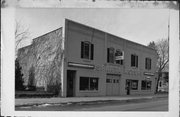| Additional Information: | Demolished 6/2000. In 1911, the present structure replaced an earlier structure and was so noted in the Sanborn-Perris fire insurance maps. In 1911, this new structure had two parts. The section facing North Water Street was a carriage house, while the other section was a large structure which housed a bus line. This bus line carried passengers and their baggage to and from the trains to their destinations. In 1916, it was called Autobus and was owned and operated by W.R. Guy and his son, Wesley.
In 1919, the building was modified and the entire building had turned into a garage, which was owned and operated by Dargel. It remained at least until 1931. Today, it is Sparta Motors, Inc.
The Dargel Garage possesses potential historical significance as an important transportation facility and garage facility in Sparta, however, little historical data is currently associated with the building and its role in the development of Sparta. It is therefore currently historically insignificant under Criterion A.
This early 20th century, two-story brick garage building features a brick facade (presently painted) thatis divided vertically into four bays by corbeled brick applied pilasters on the upper story. The facade is ornamented by a wide cornice of decorative brick work. Segmental arched window with one over one lights that are flanked by exterior shutters characterize the upper story of the facade. The lower story of the facade displays a centrally located double leafed service door, an additional entrance on the south end, and wide rectangular windows. A single entrance door is located in combination with the center window on the lower story of the facade and a service door is located on the east end of the north elevation. A small two-story brick extension with a metal covered facade, recessed from the main facade, is located on the north side of the building. Large multipaned windows are displayed on the north elevation and a small concrete block addition is located at the rear of this north extension. Service doors are located on the lower story of the facade. Characterized by stepped back brick side elevations, the Dargel Garage features an arched roof over the one-story garage section at the rear of the building. The garage section of the building displays two over two windows on the side elevations and large service doors at the rear of the building.
Generally well-preserved, the Dargel Garage Building has been altered by the extension added on the north side in 1966 and by replacement windows. The garage was extended at the rear [west end] in 1948.
This four-bay brick garage building was constructed in its present form for Ed Dargel in 1918-1919 to house his garage business. Initially, this building was a smaller three-bay brick building with arched entrances built by S.D. Edwards in 1911 to serve a bus barn and carriage house. After Edwards closed the bus barn when the business equipment was sold at a sheriff's sale in 1917, the building was sold to Ed Dargel. Dargel, utilizing some of the existing brick elevations and the facade, reconstructed the building to accomodate the then new automobile services. Iron trusses and an arched roof were added to the rebuilt one-story garage section at the rear of the building, an additional bay was added to north end of the building, a concrete floor was installed, and heat and lights also installed, turning this early carriage barn into a "modern" building of convenience. The reconstructed building was designed to accomodate 42 cars. The two-story addition on the north side was added after 1931. This early 20th century garage building has continually provided automobile based services up to the present time.
The Dargel Garage is an important example of commercial vernacular architecture. In addition, it is important as the only historic garage building in the commercial district that has retained its historic function or use. However, it has suffered alterations and better examples of the commercial vernacular building form are located at 111 East Oak (MP35/22), 113-115 East Oak (MP35/21), 211 South Water (MP36/35) and 138 North Water (MP35/34). |
|---|
| Bibliographic References: | (A) Sanborn-Perris Insurance Maps 1889, 1894, 1900, 1911, 1922, 1931.
(B) City Directory of the City of Sparta, Wisconsin. Sparta: compiled and published by E.B. Bell, 1916.
(C) City of Sparta, Wisconsin, City Development Office, Building Permit File.
(D) City of Sparta Tax Records, 1870-1930.
(E) " A Centennial Portfolio," The Sparta Herald, photograph of intersection of Water and Franklin Streets, June 6, 1983.
(F) Sparta Herald, Oct. 9, 1917. |
|---|

